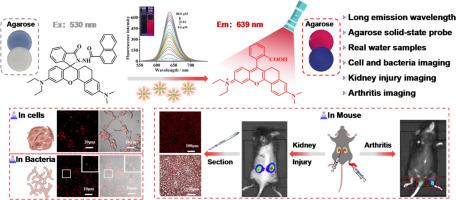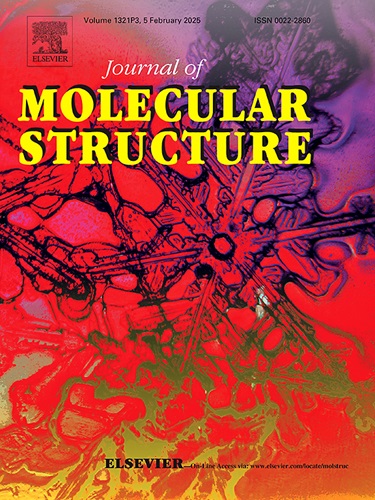用于观察炎症和药物引起的肾损伤的长波长红色发光 ClO- 荧光探针
IF 4
2区 化学
Q2 CHEMISTRY, PHYSICAL
引用次数: 0
摘要
次氯酸(ClO-)是活性氧(ROS)家族的一员,在调节生理过程和维持体内平衡方面发挥着重要作用。然而,人体内异常的 ClO- 含量与多种病理状况有关,包括炎症和肾脏疾病。在这项工作中,我们开发了一种新型荧光探针 RDNClO,专门用于灵敏检测 ClO-。RDNClO 是通过将 N - (7 - (2 - 羧基苯基) -3- (二甲基氨基) - 5,6 - 二氢 - 10H - 苯并[c]氧杂蒽 - 10 - 亚甲基) - N - 乙基乙铵 (RDNOH) 与 1-萘甲酰氯修饰而合成的。光谱分析显示,RDNClO 具有出色的性能特点,包括高选择性、25 秒的快速响应时间和 3.7 nM 的超低检测限。此外,RDNClO 还利用琼脂糖作为载体,在检测真实水样中的 ClO- 和快速鉴定环境样品中的 ClO- 方面表现出卓越的能力。它能有效监测 HeLa 细胞中的内源性 ClO- 水平和 HEK293T 细胞中的外源性 ClO- 水平。此外,RDNClO 在跟踪 ClO- 水平波动方面也表现出色,包括在大肠杆菌、k-卡拉胶诱导的关节炎小鼠模型和顺铂诱导的肾损伤小鼠模型中。RDNClO 的开发不仅为研究肾损伤的致病机制奠定了坚实的理论基础,而且为推进这一关键领域的研究提供了一个前景广阔的工具。本文章由计算机程序翻译,如有差异,请以英文原文为准。

Long-wavelength red-emitting ClO− fluorescent probe for visualizing inflammation and drug-induced renal injury
Hypochlorous acid (ClO−), a member of the reactive oxygen species (ROS) family, plays an important role in regulating physiological processes and maintaining homeostasis in the body. However, abnormal ClO− levels in the human body have been associated with a variety of pathological conditions, encompassing inflammation and kidney diseases. In this work, we have developed a novel fluorescent probe, RDN![]() ClO, specifically tailored for the sensitive detection of ClO−. RDN
ClO, specifically tailored for the sensitive detection of ClO−. RDN![]() ClO was synthesized through modifying N - (7 - (2 - carboxyphenyl) -3- (dimethylamino) - 5,6 - dihydro - 10H - benzo[c]xanthen - 10 - ylidene) - N - ethylethanaminium (RDN
ClO was synthesized through modifying N - (7 - (2 - carboxyphenyl) -3- (dimethylamino) - 5,6 - dihydro - 10H - benzo[c]xanthen - 10 - ylidene) - N - ethylethanaminium (RDN![]() OH) with 1-naphthaloyl chloride moiety. Spectroscopic analyses reveal that RDN
OH) with 1-naphthaloyl chloride moiety. Spectroscopic analyses reveal that RDN![]() ClO exhibits outstanding performance characteristics, including high selectivity, a rapid response time of <25 s, and an ultra-low detection limit of 3.7 nM. Additionally, RDN
ClO exhibits outstanding performance characteristics, including high selectivity, a rapid response time of <25 s, and an ultra-low detection limit of 3.7 nM. Additionally, RDN![]() ClO has demonstrated exceptional capabilities in detecting ClO− in real water samples and rapidly identifying ClO− in environmental samples, utilizing agarose as a carrier. It effectively monitors both endogenous ClO− levels in HeLa cells and exogenous ClO− levels in HEK293T cells. Furthermore, RDN
ClO has demonstrated exceptional capabilities in detecting ClO− in real water samples and rapidly identifying ClO− in environmental samples, utilizing agarose as a carrier. It effectively monitors both endogenous ClO− levels in HeLa cells and exogenous ClO− levels in HEK293T cells. Furthermore, RDN![]() ClO has excelled in tracking fluctuations in ClO− levels, including in Escherichia coli, the mouse model of arthritis induced by k-carrageenan, and a mouse model of cisplatin-induced renal injury. The development of RDN
ClO has excelled in tracking fluctuations in ClO− levels, including in Escherichia coli, the mouse model of arthritis induced by k-carrageenan, and a mouse model of cisplatin-induced renal injury. The development of RDN![]() ClO not only establishes a robust theoretical foundation for investigating the pathogenic mechanisms of renal injury but also presents a promising tool for advancing research in this critical area.
ClO not only establishes a robust theoretical foundation for investigating the pathogenic mechanisms of renal injury but also presents a promising tool for advancing research in this critical area.
求助全文
通过发布文献求助,成功后即可免费获取论文全文。
去求助
来源期刊

Journal of Molecular Structure
化学-物理化学
CiteScore
7.10
自引率
15.80%
发文量
2384
审稿时长
45 days
期刊介绍:
The Journal of Molecular Structure is dedicated to the publication of full-length articles and review papers, providing important new structural information on all types of chemical species including:
• Stable and unstable molecules in all types of environments (vapour, molecular beam, liquid, solution, liquid crystal, solid state, matrix-isolated, surface-absorbed etc.)
• Chemical intermediates
• Molecules in excited states
• Biological molecules
• Polymers.
The methods used may include any combination of spectroscopic and non-spectroscopic techniques, for example:
• Infrared spectroscopy (mid, far, near)
• Raman spectroscopy and non-linear Raman methods (CARS, etc.)
• Electronic absorption spectroscopy
• Optical rotatory dispersion and circular dichroism
• Fluorescence and phosphorescence techniques
• Electron spectroscopies (PES, XPS), EXAFS, etc.
• Microwave spectroscopy
• Electron diffraction
• NMR and ESR spectroscopies
• Mössbauer spectroscopy
• X-ray crystallography
• Charge Density Analyses
• Computational Studies (supplementing experimental methods)
We encourage publications combining theoretical and experimental approaches. The structural insights gained by the studies should be correlated with the properties, activity and/ or reactivity of the molecule under investigation and the relevance of this molecule and its implications should be discussed.
 求助内容:
求助内容: 应助结果提醒方式:
应助结果提醒方式:


